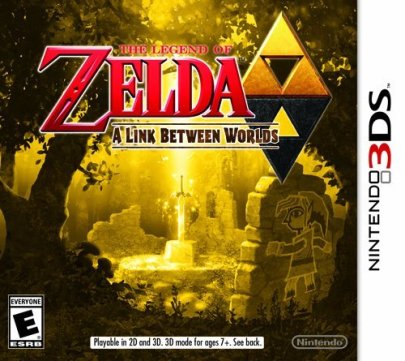Though it’s been years since I saved the kingdom of Hyrule from peril, within minutes of starting The Legend of Zelda A Link Between Worlds I was instantly reminded why I fell in love with the franchise in the first place.
Nostalgic Legend of Zelda fans don’t want Nintendo’s nearly perfect action-adventure puzzler formula messed with, but new generations need a hook to keep them interested. ALBW balances multiple generations’ worth of innovative gameplay and loads it all into a title that will undoubtedly move 3DS consoles.
A direct sequel to 1991’s The Legend of Zelda: A Link to the Past on the SNES, this title takes players across familiar fields throughout Hyrule and the dark alternate land of Lorule in an effort to stop the mysterious mage Yuga from summoning Ganon and gaining his piece of the Triforce. ALBW is a top-down 2D game like its predecessor, but the stereoscopic capabilities of the Nintendo 3DS literally and figuratively adds new depth to the whole experience. While it follows in the footsteps of the past, the dungeons and puzzles are all new- and an absolute joy to venture through.
The big gimmick this time around in A Link Between Worlds revolves around Link’s ability to magically flatten out and travel across the surface of walls, an awesome side effect of being zapped by Yuga early in the game. This ability to go flush against walls can help Link dodge and sneak past enemies, reach otherwise inaccessible areas, and travel between Hyrule and Lorule through cracks in walls.
Many of Link’s classic items make their return in ALBW, from the boomerang and bow to the Hookshot and Fire Rod. In traditional Zelda form, these items are used to solve intricate dungeons strewn across the land and fend off hordes of monsters. These items can be accessed on-the-fly during your adventure using the lower touchpad screen on the 3DS, and eventually upgraded to create impressive effects. Instead of having to cut grass for extra arrows and bombs this time around, the game utilizes a stamina meter which depletes and regenerates as items are used. Most items are also rented from the vagabond squatter Ravio (encouraging the collecting of rupees) though they can eventually be purchased.
ALBW is not without its flaws in the eyes of a handful of detractors despite all those favorable features. Some may find the game’s story to be rushed, but I find that the faster pacing is ideal for those who can only play in limited periods of time like during commutes to work or school. I’ve got a full schedule and only play on my 3DS before going to bed at night, effectively stretching the time it took to complete this game over a few weeks.
Even if you aren’t viewing the game with the rosy-colored lenses of nostalgia, The Legend of Zelda: A Link Between Worlds is ultimately an excellent entry in the storied franchise that should not be passed up.
The Legend of Zelda: A Link Between Worlds is out now on Nintendo 3DS.
